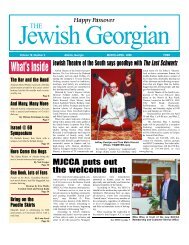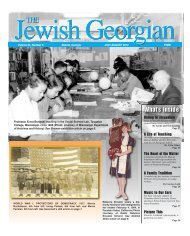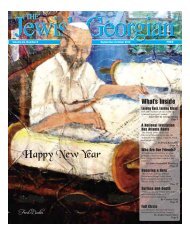You also want an ePaper? Increase the reach of your titles
YUMPU automatically turns print PDFs into web optimized ePapers that Google loves.
November-December 2010 THE JEWISH GEORGIAN Page 19<br />
Bonnie Arnold’s outstanding career began in Atlanta<br />
Bonnie Arnold is one of the most versatile<br />
producers in Hollywood, renowned for a series<br />
of landmark animated hits that have forged<br />
new, creative ground as well as for award-winning<br />
live-action features that have earned widespread<br />
acclaim, numerous Oscars, and more<br />
than $2 billion dollars in worldwide box office.<br />
This last year, Arnold produced two of the<br />
most admired films of the season: the blockbuster<br />
animated family hit How to Train Your<br />
Dragon, which won global recognition for its<br />
inventive 3-D effects and heart-stirring story<br />
line; and <strong>The</strong> Last Station, the independent film<br />
that drew awards and accolades for its entertaining<br />
and richly emotional tale about love,<br />
marriage, and Tolstoy.<br />
<strong>The</strong> two films could not be more different<br />
from a production standpoint—but they share<br />
the power of imaginative and inspired storytelling<br />
that appeals to moviegoers of all ages.<br />
Arnold’s production credits comprise an<br />
entire roster of films that share this quality—<br />
from the pioneering digital animation classic<br />
Toy Story to the epic historical drama Dances<br />
with Wolves. Her work in animation includes<br />
such hits as Over the Hedge and Tarzan, while<br />
her live-action credits include the comedy <strong>The</strong><br />
Addams Family. She has worked with such<br />
top-ranked directors as Peter Weir, Tony Scott,<br />
Stephen Frears, Barry Sonnenfeld, John<br />
Lasseter, Michael Mann, and Dean DeBlois<br />
and Chris Sanders.<br />
Arnold’s journey began in Atlanta, where<br />
she grew up going to the movies with her<br />
mother, creating memories she still treasures.<br />
From an early age, long before she was even<br />
aware of its impact, she forged a belief that<br />
families and movie-going go together.<br />
Inspired in part by Woodward and<br />
Bernstein’s dogged pursuit of the Watergate<br />
scandal, Arnold first pursued a career in journalism,<br />
studying at the University of Georgia<br />
and earning her master’s degree at Boston<br />
University.<br />
But when she returned to Atlanta, she<br />
found herself taking a job as a unit publicist on<br />
the PBS series American Playhouse’s debut<br />
production of “King of America.” Exposed to<br />
the ins and outs of filmmaking for the first<br />
time, she says she instantly caught the production<br />
bug. At this time, Atlanta was a burgeoning<br />
new hotspot for film and television production,<br />
and Arnold quickly rose to serve in a<br />
diversity of production capacities on films<br />
including Neil Simon’s <strong>The</strong> Slugger’s Wife and<br />
Peter Weir’s <strong>The</strong> Mosquito Coast.<br />
On the local scene, she became known for<br />
cultivating strong relationships, for her calm<br />
charm and creative eye—and she, in turn,<br />
caught the eye of seasoned film producer<br />
David Picker, who lured Arnold to Hollywood<br />
when he became president of Columbia<br />
Pictures in the late 1980s.<br />
With Picker as her mentor, Arnold went<br />
on to serve as production coordinator on a<br />
string of films, including Hero, starring Dustin<br />
Hoffman; <strong>The</strong> Mighty Quinn, with Denzel<br />
Washington; and Revenge, with Kevin Costner.<br />
This led to her first producing assignment,<br />
when she was asked by Costner to join his production<br />
of Dances with Wolves as associate<br />
producer. <strong>The</strong> film would go on to win seven<br />
Oscars, including Best<br />
Picture.<br />
In 1990, she moved<br />
on to Barry<br />
Sonnenfeld’s adaptation<br />
of the television classic<br />
<strong>The</strong> Addams Family,<br />
where she was<br />
immersed in the complex<br />
world of high-end<br />
special effects. <strong>The</strong> film,<br />
starring a comic ensemble<br />
cast including<br />
Anjelica Huston, Raul<br />
Julia, Christopher<br />
Lloyd, and Christina<br />
Ricci, became a smash<br />
hit, critically praised as a<br />
visual funhouse of a<br />
family comedy.<br />
This, in turn, led to<br />
an unusual opportunity—to produce the first<br />
feature film from an upstart Northern<br />
California animation studio known as Pixar:<br />
Toy Story. Although Arnold had never worked<br />
in animation before, let alone the brave new<br />
world of computer-generated characters, she<br />
instantly recognized that something special<br />
was happening amid the devoted young team<br />
of writers and animators headed by John<br />
Lasseter.<br />
Armed with her knowledge of how to<br />
make a complex movie on a budget and ready<br />
to learn in a trial-by-fire fashion, she began a<br />
three-and-a-half year odyssey that would result<br />
in one of the most critically admired and successful<br />
family films of all time, nominated for<br />
three Oscars and winner of eight Annie Awards<br />
(the industry’s animation awards), which has<br />
since become part of the fabric of 21st-century<br />
popular culture.<br />
On the heels of Toy Story’s unprecedented<br />
appeal, Arnold became the rare woman producer<br />
known for her ability to shepherd the<br />
biggest animated features to the screen. She<br />
next produced Disney’s Tarzan, featuring the<br />
integration of traditional and computer animation<br />
techniques called “Deep Canvas” that<br />
pushed the state-of-the-art to the next level.<br />
<strong>The</strong> film received 11 Annie Award nominations<br />
and an Academy Award and Golden Globe<br />
nomination. In 2006, Arnold teamed with<br />
DreamWorks Animation for the first time on<br />
Over the Hedge, featuring a clan of woodland<br />
creatures who unite against a suburban community<br />
encroaching on their wilderness home,<br />
which garnered eight Annie Awards.<br />
Yet even as Arnold was committed to the<br />
painstaking, labor-intensive work of bringing<br />
larger-than-life animated stories to the screen,<br />
she was also passionately pursuing a liveaction<br />
story she had been intrigued with for<br />
over a decade. This was <strong>The</strong> Last Station,<br />
which she first encountered when actor<br />
Anthony Quinn, with whom Arnold worked on<br />
Revenge, introduced her to the novel by Jay<br />
Parini about Tolstoy’s tumultuous final year. At<br />
the heart of the story, Arnold saw a timeless<br />
and resonant tale about the ravages and wonders<br />
of love and marriage.<br />
Bonnie Arnold<br />
In the early 1990s, Quinn and Arnold<br />
began developing the<br />
project, but after Quinn’s<br />
death in 2001, Arnold was<br />
determined to bring the<br />
film to fruition. Things<br />
took a turn when she partnered<br />
with writer/director<br />
Michael Hoffman<br />
(Restoration, One Fine<br />
Day). <strong>The</strong> result was<br />
Hoffman’s stylish and<br />
witty screenplay, plus<br />
complex and juicy roles<br />
that attracted major talent,<br />
including Helen Mirren,<br />
Christopher Plummer,<br />
James McAvoy, and Paul<br />
Giamatti.<br />
At the same time,<br />
Arnold was immersed in a<br />
very different, four-year<br />
labor of love: bringing the 3-D animated<br />
adventure comedy How to Train Your Dragon<br />
to the screen for DreamWorks Animation. This<br />
was another envelope-pushing project for<br />
Arnold, one that would merge thrillingly<br />
inventive, three-dimensional action with a<br />
touching tale about a Viking teen who finds his<br />
own path to becoming a hero. Arnold oversaw<br />
a creative team numbering more than 500 who<br />
breathed new fire into the animation realm,<br />
creating a film that felt like no other animated<br />
feature before it. Full of both emotional depth<br />
and 3-D beauty, it won unprecedented critical<br />
praise.<br />
How to Train Your Dragon was released<br />
on DVD and Blu-ray on October 15.<br />
How to Train Your Dragon and <strong>The</strong> Last<br />
Station were released within months of each<br />
other—and, though they took the most divergent<br />
paths, each was a major success on its own<br />
terms. <strong>The</strong> Last Station garnered two Oscar<br />
nominations, as well as nominations from the<br />
Screen Actors Guild, the Golden Globes, and<br />
the Independent Spirit Awards (including a<br />
nomination for Best Picture). How to Train<br />
Your Dragon became one of the first major<br />
box-office hits of 2010 and garnered critical<br />
raves, including the Persol 3-D Award for the<br />
Most Creative 3-D Film of 2010 from the<br />
Venice Film Festival.<br />
Arnold is currently developing a sequel to<br />
How to Train Your Dragon with writer/director<br />
Dean DeBlois. DreamWorks Animation SKG<br />
3D will bring this 3D sequel to the screen in<br />
2013. It will again feature the voice talents of<br />
Jay Baruchel, Craig Ferguson, America<br />
Ferrera, Jonah Hill, Christopher Mintz-Plasse,<br />
T.J. Miller, and Kristen Wiig.<br />
Despite the contrasting nature of How to<br />
Train Your Dragon and <strong>The</strong> Last Station, for<br />
Arnold, they both represent what she wants to<br />
achieve in the entertainment business: making<br />
movies with a heartfelt appeal that crosses generations.
















